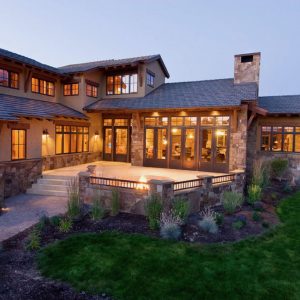Hi all, We are building a modern mediterranean home in Central Oregon. The exterior is stucco and stone and there are wood faux timber headers over the top of each window. See sample inspiration pic below. I am trying to decide on what type of wood would work best as a timber header; western red cedar, doug fir, or other. Something that won’t rot easily and won’t need yearly attention. I like the way cedar ages and turns gray over time but in central oregon we get snow and low temps so I am not sure cedar won’t get moisture stains. I have doug fir timbers in an outdoor patio/kitchen at our current home in the NW and the beams that see direct weather need pressure washing and stain every other year to keep them from turning black (and I’m losing the battle). Does anyone have any experience or advice about the type of wood that works best in this application?
I would also be interested in any flashing advice. I have solid plans and details for waterproofing and flashing for the top of the timber but I am concerned about the lower left and right corners of the timber. The timbers extend 4″ horizontally beyond the window frame so the lower left and right corners will be contact with the stucco. How do you keep water from getting trapped in the corners?
Sorry for the long post and I appreciate any help. Thank you




















Replies
Faux wood for your faux header seems like it might work.
You probably can treat the bottom edges like the sill of a window. Slant the lower surface, and install a slot to break the path for water to run back into the building.
Looks like your timbers extend out past the surface of the stucco, so there should be room.
I've looked at precast faux wood but I have a few long spans. I think it would work. I would just be hard to install without breaking. I like the bevel idea. 5% to 7% down edge. That's good. Thanks
I assume that you are going to fully sheath the exterior. Install the windows as you normally would if the faux header were not there. Wrap the exterior for stucco and fully flash the windows. Use 2x for the faux header. Install this above the window. Above the header use an 1 1/2" or 2" piece of L metal with a drip edge so that it turns down over the header. Lap stucco paper over this metal and continue it up to the next lap or to the top. Now install the stucco wire and trim as you normally wood. As an extra precaution you could use two sided sticky flashing behind the header. I've done this many times without problems.
For the header you could use redwood if you can get it. You can finish it to a natural gray using baking soda and water. Or douglas fir with a quality exterior stain. This should give you very little maintainance.
Yes, 1/2" sheeting and I am good with the wrap, waterproofing and drip edge for the top portion. I am qualified there. You are correct that I plan to use a full 2" faux timber. The wood is real. The header will look like a timber but it will be faux in the sense that it will only be 2" deep and attached to the sheeting. It will protrude about an inch from the face of the stucco.
My concern is the type of wood as a timber and the trapping of moisture at the corners of the stucco in the lower left and right hand edges of the timber. Beveling the bottom of the timber as stated above is a good idea. I could flash that too I suppose. Some people have told me red cedar is not as weather resistant as doug fir which surprised me. I will look into the redwood. That species is not in the yards around here but only about 500 miles south.
Thanks for the help.
Look into spruce as well. It is commonly used in fascia which is about as exposed as you can get. It comes dry, relatively knot free, it is light weight and not prone to warping or twisting. Spruce fascia comes rough sawn and takes stain well. Even though it is rough sawn it is seldom more than 1 1/2" net thickness.
I wouldn't mount the headers in the wall at all. I'd "age" the edges of some Pvc trim and install it on top of the wall. No risks of leaks ever.
Stuff attached to the surface of stucco will never look like anything other than stuff attached to the surface of stucco.